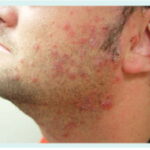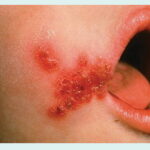Fusobacterium species are obligate anaerobic, gram-negative bacilli commonly found in the oropharynx, gastrointestinal tract, and genitourinary system. Though often commensal, these bacteria can cause severe infections under the right conditions, particularly when the skin barrier is compromised. Among soft tissue pathogens, Fusobacterium necrophorum and Fusobacterium nucleatum are notable for their involvement in necrotic skin and skin structure infections (SSSIs), especially in immunocompromised patients or those with polymicrobial wounds.

Pathogenesis of Fusobacterium in Skin and Soft Tissue Infections
Fusobacterium thrives in anaerobic environments, particularly in necrotic or poorly perfused tissue. It contributes to infection via several virulence factors:
- Leukotoxin production: Induces cell death and immune evasion
- Endotoxins: Promote inflammation and tissue damage
- Synergism with aerobes: Enhances pathogenicity in polymicrobial infections
- Biofilm formation: Promotes chronicity and antibiotic resistance
These features make Fusobacterium a critical component in deep tissue infections, including abscesses and necrotizing fasciitis.
Clinical Manifestations of Fusobacterium SSTIs
Anaerobic Cellulitis
- Slowly progressing erythema and swelling
- Foul-smelling exudate
- Gas formation occasionally observed in deep tissues
Cutaneous Abscesses
- Tender, fluctuant lesions with purulent drainage
- Often involve anaerobic–aerobic synergy
- High prevalence in perirectal, perineal, and head-neck regions
Necrotizing Fasciitis (Type I)
- Polymicrobial, with Fusobacterium acting synergistically with streptococci and enterobacteria
- Rapidly spreading infection along fascial planes
- Presents with severe pain, systemic toxicity, crepitus, and skin discoloration
Lemierre’s Syndrome with Skin Involvement
- Rare but severe, originating from oropharyngeal infections
- Can result in septic thrombophlebitis with metastatic abscesses in soft tissues
Risk Factors for Skin and Skin Structure Fusobacterium Infections
| Risk Factor | Contribution to Infection |
|---|---|
| Poor hygiene and chronic wounds | Create anaerobic microenvironments |
| Surgical procedures | Breach the natural barrier and introduce anaerobes |
| Immunosuppression | Reduces host defense, enabling opportunistic infections |
| Dental infections or abscesses | Act as primary foci, leading to secondary skin infections |
| Diabetes mellitus | Impairs circulation and neutrophilic response |
| Peripheral vascular disease | Favors anaerobic colonization in ischemic tissues |
Diagnostic Workup of Suspected Fusobacterium SSTIs
Clinical Examination
- Foul odor, necrosis, or gas production suggest anaerobic involvement
- Pain out of proportion to physical findings is a red flag in necrotizing infections
Microbiological Testing
- Tissue biopsy or abscess aspirate preferred for culture
- Anaerobic culture under strict transport and incubation conditions
- Gram stain: Spindle-shaped gram-negative rods may be seen
- Molecular diagnostics (PCR): Increasingly used for rapid identification
Imaging Studies
- CT/MRI: Evaluate for gas formation, extent of tissue involvement, or fluid collections
- Ultrasound: May help identify abscesses but limited in deep tissue pathology
Antimicrobial Susceptibility and Resistance Patterns
While many Fusobacterium species remain sensitive to beta-lactam antibiotics, resistance is emerging due to beta-lactamase production. Key considerations include:
- Penicillin susceptibility: Decreasing due to beta-lactamase
- Metronidazole: Highly active, first-line agent
- Clindamycin: Variable resistance; should not be used alone without susceptibility data
- Carbapenems: Broad anaerobic coverage, preferred in polymicrobial infections
- Beta-lactam/beta-lactamase inhibitor combinations: Piperacillin-tazobactam effective
Treatment Strategies for Fusobacterium Skin and Skin Structure Infections
Empiric Therapy
Initiate broad-spectrum anaerobic coverage, especially in serious or polymicrobial infections:
- Metronidazole or Piperacillin-tazobactam
- Carbapenems (e.g., meropenem) for life-threatening or necrotizing infections
- Combine with coverage for gram-positives and facultative gram-negatives as needed
Directed Therapy
Based on culture and sensitivity results:
| Organism | Preferred Therapy |
|---|---|
| F. necrophorum | Metronidazole |
| F. nucleatum | Metronidazole or beta-lactam combo |
| Beta-lactamase producing strains | Carbapenem or piperacillin-tazobactam |
Duration of Therapy
- Uncomplicated abscess: 7–10 days post-drainage
- Necrotizing fasciitis: ≥14 days, depending on surgical findings
- Polymicrobial infections: Tailor based on response and severity
Surgical Management and Wound Care
Incision and Drainage
- Mandatory for abscess management
- Facilitates microbial clearance and penetration of antibiotics
Debridement
- Aggressive removal of necrotic tissue in necrotizing infections
- May require repeated procedures in severe cases
Advanced Wound Care
- Negative pressure wound therapy (NPWT)
- Moist dressings with antimicrobial properties (e.g., silver, iodine)
Infection Prevention and Control
- Aseptic surgical technique and proper wound closure
- Prompt management of dental and oropharyngeal infections
- Early treatment of chronic ulcers to prevent anaerobic colonization
- Educating patients on hygiene and wound care
Complications of Untreated Fusobacterium Infections
| Complication | Description |
|---|---|
| Sepsis | Common in necrotizing fasciitis and deep abscesses |
| Tissue necrosis | May necessitate amputation or reconstructive surgery |
| Septic thrombophlebitis | Especially in Lemierre’s syndrome |
| Chronic wounds | Due to unresolved anaerobic colonization |
| Multi-organ dysfunction | In fulminant systemic infections |
Prognosis and Clinical Outcomes
Outcomes are largely dependent on the speed of diagnosis and intervention. Delayed treatment increases the risk of mortality, especially in necrotizing forms or if systemic involvement occurs.
| Infection Type | Prognosis |
|---|---|
| Localized abscess | Excellent with timely drainage |
| Polymicrobial cellulitis | Good with broad-spectrum therapy |
| Necrotizing infection | Guarded; requires intensive care |
| Lemierre’s syndrome | Requires prolonged therapy and monitoring |
Fusobacterium species, while often overlooked, are critical anaerobic pathogens in skin and skin structure infections. Timely recognition, appropriate antibiotic therapy, and surgical intervention are essential to mitigate complications. Given their increasing role in polymicrobial and necrotizing infections, clinicians must maintain a high index of suspicion and adopt a multidisciplinary approach to care.

